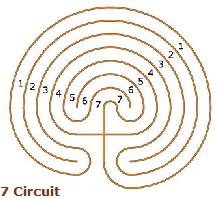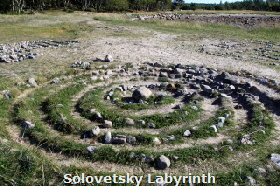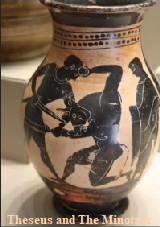Part I THIS PAGE Introduction
What is a Labyrinth? Labyrinths Vs. Mazes. Ancient Labyrinths. Greek Mythology. From Greek Mythology to Catholic Churches
Labyrinths found their way into Christianity sometime during the Middle Ages The Gothic Cathedrals
Apparently more than twenty of the eighty Gothic cathedrals housed labyrinths From Chartres to San Francisco and Beyond
Lauren Artress and Veriditas The Modern Labyrinth Walk
Labyrinth walks are often accompanied by trappings usually seen to "spiritualize" the atmosphere,
Part II - Next Page
The Labyrinth and Pagan Spirituality. Labyrinths, Contemplative Prayer and An Altered State Of Consciousness. Labyrinths -.A Connection with the Divine... For Everyone? Is Labyrinth-Walking Compatible With Christianity? Quislings in The Church. Conclusion. Footnotes: The Druids. Chartres Cathedral and the Cult of the Black Madonna. Grace Cathedral - A Literal Den of Vipers
Introduction:
What is a Labyrinth?
Labyrinths are unicursal - they have one well-defined path that leads us into the center and back out again. The path winds back and forth in a series of concentric rings from the entrance on the perimeter to the center where you pause, turn around and walk back out again. Because there is only one path, the word 'circuit' describe the number of times the path circles around the center of the labyrinth. The Cretan or Classical 7-circuit labyrinth that is perhaps the oldest and most used of all labyrinth designs goes around seven times. The eleven circuit labyrinth meanders around the center eleven times. in a series of concentric rings from the entrance on the perimeter to the center where you pause, turn around and walk back out again. Because there is only one path, the word 'circuit' describe the number of times the path circles around the center of the labyrinth. The Cretan or Classical 7-circuit labyrinth that is perhaps the oldest and most used of all labyrinth designs goes around seven times. The eleven circuit labyrinth meanders around the center eleven times.
Labyrinths can be made of large stones or brick, or simply a path cut into grass. They can be patterns set into a tiled floor or printed on canvas. They can be elaborate and very expensive, or cost nothing at all. Labyrinths Vs. Mazes:
Although the words labyrinth and maze are frequently confused in the English language, they are not the same thing.. Mazes are essentially a game and a test of skill. Theyvcan have more than one entrance, numerous choices of path and direction and several dead end cul-de-sacs. The walls are usually high enough to block one from seeing the way out. They are designed to pose some difficulty in finding ones way in, or out of them. Labyrinths: Unlike the maze the labyrinth is not designed to be difficult to navigate. It has only a single winding path which leads to the center and out again with no diverging paths or dead-ends along the way.
Ancient Labyrinths
While the word labyrinth is closely tied to Greek mythology, labyrinths have been found in cultures around the globe often constructed as far back as 3,500 years, although the earliest are often difficult to date accurately. For example, One of the most famous labyrinths of the  ancient world was housed in an Egyptian pyramid complex built in the 12th Dynasty (1844-1797 B.C.) at Hawara by Amenemhet III. [01] ancient world was housed in an Egyptian pyramid complex built in the 12th Dynasty (1844-1797 B.C.) at Hawara by Amenemhet III. [01]
The Solovetsky Islands an archipelago located in the Onega Bay of the White Sea, Russia contain 35 labyrinths that date to some 3,000  years ago, [02] years ago, [02] One of the oldest dateable labyrinth designs was found inscribed on a clay tablet from Pylos, Greece that dates back to 1200 BCE. A 56 feet X 56 foot 2,000 year old square labyrinth discovered in the south of India, bears exactly the same pattern as the Greek Pylos tablets. [03] The symbol has appeared in various forms and media (petroglyphs, classic-form, medieval-form, pavement, turf, and basketry) at some time throughout most parts of the world, from Native North and South America to Australia, Java, India, and Nepal. See Foot note I The Universal Labyrinth.
Greek Mythology:
The word labyrinth comes from the ancient Greek words labrys - an iconic double axe and inthos - place. Thus, labryinthos has been interpreted to mean house of the double-headed axe. [04]
In Greek mythology the Minotaur, a mythical monster with the body of a man and the head of a bull was the offspring of Minos' wife Pasiphae and a snow-white bull sent to Minos by the god Poseidon. Minos had the architect Daedalus construct a labyrinth to house the monster and ensure it wouldn't escape. However, wouldn't escape. However, A son of Minos, Androgeos, was later killed by the Athenians; to avenge his death, Minos demanded that seven Athenian youths and seven maidens should be sent every ninth year (or, according to another version, every year) to be devoured by the Minotaur. When the third time of sacrifice came, the Athenian hero Theseus volunteered to go, and, with the help of Ariadne, daughter of Minos and Pasiphae, he killed the monster and ended the tribute. Theseus escaped with Ariadne. [05]
Intriguing clues include century BCE coins from Knossos (on Crete) struck with simple seven-circuit labyrinth symbols, spiral labyrinth designs on coins and pottery, hundreds of bull horns carved in stone and wall paintings of young men leaping over charging bulls have led many to conclude that the huge Minoan palace at Knosso is usually identified as the location of the Minotaur's labyrinth. Although the story is myth, Carl Teichrib makes a very valid point, (Emphasis Added) "The labyrinth containing this Minotaur was not the typical single-path labyrinth of today, but rather a complex maze containing halls and chambers. However, esoteric philosophers have long understood that the Minotaur maze directly corresponds to the ancient (and now modern) spiritually-connected labyrinth walk; the long soul journey with its many twists and turns, the ultimate arrival at the central convergence point, the struggle with the inner monster - and the final victory over the forces of darkness and ignorance (which can only happen when one is illumined at the center), and the repeated journey back to wholeness and the light of day. This esoteric significance of the Cretan story has never been lost on the initiates of the Mystery Schools.
Don't forget, this Grecian/Cretan story was immersed in the pagan religious context of the day, that's the metaphysical origin of the labyrinth as we can trace it. Hence the story of Pasiphaë, with its labyrinth journey and inner battle, is of interest first and foremost to the world of occult lore: for the simple reason that this is the intended context. [06]
From Greek Mythology to Catholic Churches
While the history of labyrinths is sketchy, some believe they found their way into Christianity during the Middle Ages. Apparently,
Many Christians during that time attempted to make pilgrimage to the Holy City of Jerusalem at some point in their lives but the Crusades made the visits increasingly difficult, if not impossible. Labyrinths were constructed in and around many Catholic cathedrals as a substitute, allowing Christians to fulfill their obligations (some seemed to believe these pilgrimages were necessary for salvation) symbolically. [07]
On the other hand, there is seemingly no firm evidence that ancient or medieval Christians literally walked labyrinths - at Chartres or anywhere else. Some proponents believe that medieval Christians walked through labyrinths as a substitute for pilgrimages to the Holy Land. To support their theory, they point to the placement of labyrinths on cathedral floors as opposed to walls or ceilings. Labyrinths in medieval cathedrals and churches almost certainly had symbolic meaning, although documentation is scarce to nonexistent. One possibility is that the ancient Greek myth was Christianized, so that the Minotaur represented the devil, and Theseus represented the victorious Christ. Doreen Prydes, a professor of medieval history at the University of Notre Dame, says there is absolutely no evidence of labyrinth walking in the Middle Ages. She believes that Christians of that era saw the labyrinth as a symbol of redemption, not pilgrimage. [08]
However, there is no question that one woman who uncovered a previously hidden and long forgotten relic in an old Gothic Cathedral in France led to countless thousands of labyrinths being used around the world.
The Gothic Cathedrals
In the twelfth and thirteenth centuries medieval labyrinth designs came into their own with the construction of hugely ornate labyrinths in various cathedrals, several of which are a short distance from Paris - such as the octagonal one at the Cathedrals of Amiens and the unique path pattern labyrinth in the Cathedral of Notre-Dame at Reims. The Duomo di Siena in Tuscany (central Italy) dates from about the same period. Apparently more than twenty of the eighty Gothic cathedrals housed labyrinths.
Chartres Cathedral (Cathédrale Notre-Dame de Chartres):
However the most famous of these labyrinths is the large eleven-circuit one (43 feet in diameter) embedded in the paving stones of the nave floor of Chartres Cathedral (50 miles from Paris). However the labyrinth at Chartres Cathedral had been long forgotten, covered with furniture for seating, and, as far as anyone knew, hadn't been used in decades. In fact, until recently, the cathedral was better known for its stained-glass windows than for the labyrinth on its floor. So how did a labyrinth go from being an almost forgotten relic in an old Gothic Cathedral in France to being the prototype for countless thousands of labyrinths around the world? Jean Houston
Jean Houston, author of 26 books, has been called one of the foremost visionary thinkers and doers of our time and long regarded as one of  the principal founders of the Human Potential Movement. She has been working with the United Nations Development Program since 1993. the principal founders of the Human Potential Movement. She has been working with the United Nations Development Program since 1993. In 1965, along with her husband Dr. Robert Masters, Dr. Houston founded The Foundation for Mind Research. She is also the founder and principal teacher, since 1983, of the Mystery School, now called the Renaissance of Spirit, a school of human development, a program of cross-cultural, mythic and spiritual studies, dedicated to teaching history, philosophy, the New Physics, psychology, anthropology, and the many dimensions of human potential. [09]
However, most relevant to this article is the fact that Jean Houston introduced Lauren Artress - the 'mother' of the modern labyrinth movement to the Chartres Cathedral labyrinth and, by extension, to the rest of the country.
From Chartres to San Francisco and Beyond
Lauren Artress and Veriditas ("the greening power of life")
Lauren Artress is Canon for Special Ministeries at San Francisco's Grace Cathedral. She is also the founder of Quest: Grace Cathedral Center for Spiritual Wholeness and the creator of the Labyrinth Project. Here is how it all started, Center for Spiritual Wholeness and the creator of the Labyrinth Project. Here is how it all started, In her book, Walking a Sacred Path: Rediscovering the Labyrinth as a Spiritual Tool, Lauren Artress writes that in 1991, in preparation for an invitation to serve as Canon for Special Ministries, she decided "to return to a Mystery School seminar with Dr. Jean Houston" whom she had studied with a few years earlier. It was here that she says she first encountered the labyrinth, described as a "a powerful spiritual tool whose path would lead each of us to our own center". After experiencing the Labyrinth at Jean Houston's Mystery School. [25] Artress notes that she was hardly prepared for the force of my own reaction. As soon as I set foot into the labyrinth I was overcome with an almost violent anxiety. Some part of me seemed to know that in this ancient and mysterious archetype, I was encountering something that would change the course of my life. [10]
The idea gestated for a few months and then she was compelled to go to Chartres Cathedral, where she moved the chairs and walked the medieval labyrinth. This courageous act has led to the rediscovery of the labyrinth. Lauren not only introduced the walking meditation back into the Christian tradition but also introduced the labyrinth back into Western culture. [11] Artress is also the Founder and Creative Director of Veriditas, "dedicated to inspiring personal and planetary change and renewal through the labyrinth experience". [12] By December 1991, she had replicated the Medieval Eleven Circuit Labyrinth at Grace Cathedral beginning in canvas form. Due to the enormous response of people desiring to learn a walking meditation, the tapestry labyrinth was installed inside the Cathedral in 1994. The outdoor terrazzo labyrinth was installed in the Interfaith Meditation Garden in 1995. In 2007, Grace Cathedral installed a permanent limestone labyrinth in the floor to replace the tapestry labyrinth. Veriditas is storing the carpet until it can realize its vision of a retreat center where the tapestry labyrinth will once again have a home. [11]
Veriditas' Reasons To Be:
The initial vision for Veriditas was "peppering the planet with labyrinths. After successfully launching thousands of labyrinths in churches, hospitals, cathedrals, prisons, spas, community parks, hospices and other settings, a new mission for Veriditas emerged: To facilitate the transformation of the human spirit through offering the Labyrinth Experience". [13] Mission: Veriditas is dedicated to inspiring personal and planetary change and renewal through the labyrinth experience. We accomplish our mission by training and supporting labyrinth facilitators around the world, and offering meaningful events that promote further understanding of the labyrinth as a tool for personal and community transformation. Our Vision is that the labyrinth experience guides us in developing the higher level of human awareness we need to thrive in the 21st century. [14]
And she certainly got a good start. While the numbers can not be pinned down, Veriditas has a "World-Wide Labyrinth Locator" on their site. A search for labyrinths in Washington State alone resulted in over 175 results, 52 of which were connected with churches within a 100 mile radius of Seattle. A large number seemed to be Episcopalian churches with a few Methodist, Lutheran etc. thrown in for good measure. Incidentally Anne Bull, Veriditas' marketing, communications, and website manager's "spiritual journey has included many years of meditation practice. She is now an assistant Zen Teacher and an ordained Soto Zen Buddhist Priest. She served on the High Mountain Crystal Lake Zen Community Board of Directors for seven years. During that time she also worked part-time as their Communications Director" [15] The Legacy Labyrinth Project (LLP) “began as a Veriditas board project in 2011 and became its own non-profit organization with the mission to physically connect labyrinths globally to create a constellation of labyrinths for peace and healing to all who walk their path. While the Reverend Dr. Lauren Artress was instrumental in "peppering the planet" with labyrinths, LLP is now networking them into something powerful for the Earth as a whole”. [16]
The Modern Labyrinth Walk:
Labyrinth walks are often accompanied by candles, soothing music, flowers and/or fragrance - trappings usually seen to create a setting 'conducive to reflection' or, if you will, "spiritualize" the atmosphere,
 While every one seems to agree that there is no right way to walk a labyrinth, some suggestions include - Taking time to transition from everyday life to the labyrinth experience, slowing your breathing and stilling your mind while opening yourself to possibilities. It is often suggested that you spend time in the center standing, sitting, or kneeling since this part of the journey is about being present to your inmost self and to the "power of the divine". While every one seems to agree that there is no right way to walk a labyrinth, some suggestions include - Taking time to transition from everyday life to the labyrinth experience, slowing your breathing and stilling your mind while opening yourself to possibilities. It is often suggested that you spend time in the center standing, sitting, or kneeling since this part of the journey is about being present to your inmost self and to the "power of the divine".
The web site of The Labyrinth at Trinity Episcopal Church in Elmira, NY, says As with all practices of prayer or meditation, your experience will grow and deepen the more you do it. Some people feel a sense of peace. Others find old memories rising up as they walk. Others find themselves thinking about an immediate situation or person. Others walk at varying speeds as different thoughts and emotions come and go. Some people experience physical sensations, perhaps become light-headed, or have a feeling of floating above, a feeling of weight, or of great warmth. Some people have profound insights. Others have very small experiences or none at all.
The experience of walking the labyrinth is different for each person, each time. Whatever you experience, it is your experience. Relax and see what happens... Enjoy the sensation of traveling without any particular sense of destination; for once, let yourself be a "holy wanderer," enjoy the meandering path and let yourself feel aimless. [17] Grace Cathedral, which now boasts two labyrinths.. an indoor and an outdoor one, says.. There are three stages of the walk (Emphasis Added) Purgation (Releasing) ~ A releasing, a letting go of the details of your life. This is the act of shedding thoughts and distractions. A time to open the heart and quiet the mind. Illumination (Receiving) ~ When you reach the center, stay there as long as you like. It is a place of meditation and prayer. Receive what is there for you to receive. Union (Returning) ~ As you leave, following the same path out of the center as you came in, you enter the third stage, which is joining God, your Higher Power, or the healing forces at work in the world. Each time you walk the labyrinth you become more empowered to find and do the work you feel your soul reaching for. [18]
Footnote I - The Universal Labyrinth:
The Romans: The labyrinth was a design commonly used for ancient Roman floor mosaics usually derived from the simple classical labyrinths. An image of a minotaur often appears in the center of these mosaic labyrinths.
Egypt: During the 19th century, the remains of the Labyrinth were discovered some 11.5 miles from the pyramid of Hawara. This complex of buildings with galleries and courtyards was called a "labyrinth" by Herodotus. Scandinavia: Some ancient stone labyrinths have been found in Scandinavia, Lappland, Iceland and the former Soviet Union. These were made on grass or on flat areas of bare rock, their paths usually marked out with stones, most often in the simple classical form. During the twelfth and thirteenth centuries some 500 or more non-ecclesiastical labyrinths were constructed in Scandinavia. "Ancient Scandinavian sailors believed the labyrinth had magical properties and when walked could control the weather and ensure a good catch". Spain: A collection of labyrinth designs carved on rock outcrops along the coastline of Galicia in Northwest Spain and a panel in León some 200 km away seem to date back to c.2500-1800 BCE. [19]. Britain: The earliest known use of the classical labyrinth pattern in the British Isles is on the Hollywood Stone, an incised granite boulder from County Wicklow, Ireland, dating from c. 550 AD. One ancient turf maze, called Julian's Bower, still survives at Alkborough in North Lincolnshire. "the nearby Alkborough church has a copy of the maze inlaid into the porch floor, and this is used as a template for the periodic re-cutting of the turf". Native American: The Hopi Indians called the labyrinth the symbol for "mother earth" while.. "Labyrinth petroglyphs found throughout Arizona, New Mexico and the northern states of Mexico are difficult to date, but provide the earliest evidence for labyrinths in the Southwest. Today the labyrinth remains popular and is found as the familiar "Man in the Maze" motif on hand woven baskets, silver work and pottery produced by the native peoples of Arizona, especially the Tohono O'dham (from the Sonoran Desert of the southeastern Arizona and northwest Mexico) and Navajo."
Continue on to Part II - The Labyrinth and Pagan Spirituality. Labyrinths, Contemplative Prayer and An Altered State Of Consciousness. Labyrinths -.A Connection with the Divine... For Everyone? Is Labyrinth-Walking Compatible With Christianity? Quislings in The Church. Conclusion. Footnotes - The Druids. Chartres Cathedral and the Cult of the Black Madonna. Grace Cathedral - A Literal Den of Vipers. HERE
End Notes - The Labyrinths Part I
[01] Walk the World’s Most Meditative Labyrinths.
https://www.smithsonianmag.com/travel/walk-worlds-meditative-labyrinths-180957823/#rhWwXgq462MlOz0F.99
[02] Geordie Mcelroy. 10 Mysterious Ancient Labyrinths. https://listverse.com/2017/02/26/10-mysterious-ancient-labyrinths/ February 26, 2017 [03] Ancient Pages. [http://www.ancientpages.com/2015/08/08/2000-year-old-labyrinth-square-discovered-in-india-its-pattern-is-identical-to-seen-on-greek-pylos-tablets/
[04] https://www.ancient-origins.net/ancient-places-asia/ancient-stone-labyrinths-bolshoi-zayatsky-001573 [05] Editors of Encyclopaedia Britannica. https://www.britannica.com/topic/Minotaur [06] Carl Teichrib. The Labyrinth Journey: Walking the Path to Fulfillment? http://www.crossroad.to/articles2/05/teichrib/labyrinth.htm [07] Pastor Gary Gilley. Mysticism – Part 4. https://tottministries.org/mysticism-part-4/ [08] Mark Tooley. Maze Craze. Labyrinths Latest Fad for Spiritual Seekers. Touchstone Magazine http://touchstonemag.com/archives/article.php?id=13-07-046-r [09] http://www.jeanhouston.com/Jean-Houston/ [10] Lauren Artress. Walking a Sacred Path: Publisher: Riverhead Books; Revised and Updated ed. edition (March 7, 2006). Pages 1-2 [11] Founder: The Reverend Dr. Lauren Artress. https://veriditas.org/staff [12] About Veriditas. https://veriditas.org/page-1863725 [13] Introduction to the Labyrinth. https://veriditas.teachable.com/p/introduction-to-the-labyrinth [14] https://www.veriditas.org/about/staff.shtml [15] https://veriditas.org/staff [16] https://veriditas.org/Legacy-Labyrinths [17] How to walk the Labyrinth. https://www.labyrinthsofchemungcounty.org/how-to-walk-the-labyrinth [18] Grace Cathedral Web site. Our Labyrinths https://gracecathedral.org/our-labyrinths/ [19] Jeff Saward The First Labyrinths. http://www.labyrinthos.net/First%20Labyrinths.pdf |